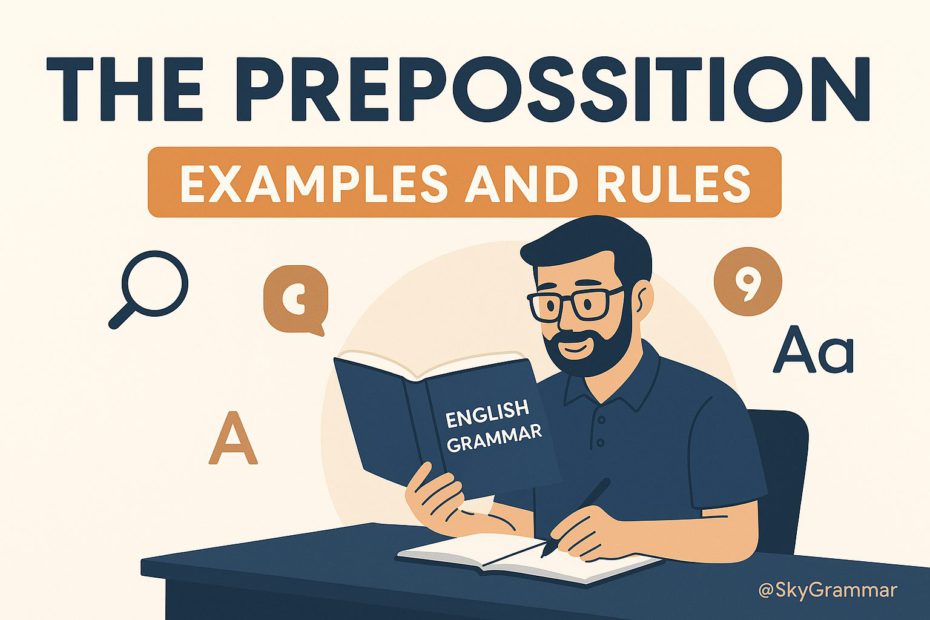Prepositions are one of the most important parts of speech in English. Though they’re usually small words like in, on, at, or under, their role is anything but small. Prepositions are the bridge between words in a sentence, helping establish relationships involving time, space, direction, cause, manner, and more.
In this guide, we’ll explore what prepositions are, the different types of prepositions, common examples, usage rules, and common mistakes. By the end, you’ll understand how these modest little words help structure the English language.
🔍 What Is a Preposition?
A preposition is a word that links a noun, pronoun, or noun phrase (called the object of the preposition) to another word in the sentence. It often tells us when, where, or how something happens.
Examples:
- The cat is under the table.
- She arrived after dinner.
- We walked through the park.
In each case, the preposition connects the object (the table, dinner, the park) to the rest of the sentence, providing important context.
📂 Types of Prepositions (With Examples)
Prepositions are classified according to the specific relationships they establish between elements in a sentence. Let’s break them down.
1. Prepositions of Place and Position
These prepositions indicate the physical location of something.
Examples: on, in, under, above, below, between, next to, behind, in front of
- The book is on the table.
- He sat between his parents.
2. Prepositions of Time
These show when something happens.
Examples: at, on, in, before, after, during, since, until
- We will meet at 5 p.m.
- She was born in July.
- I haven’t seen him since Monday.
3. Prepositions of Direction or Movement
These indicate motion or direction toward something.
Examples: to, into, onto, out of, from, toward, across
- She ran into the room.
- They walked toward the station.
4. Prepositions of Cause, Reason, or Purpose
These express the reason for something.
Examples: because of, due to, owing to, for, from
- The match was canceled because of the rain.
- She was tired from working all day.
5. Prepositions of Manner, Instrument, or Agent
These show how something is done, or by whom/what.
Examples: by, with, like, as
- The letter was written by Sarah.
- He cut the paper with scissors.
✏️ How Prepositions Are Used in Sentences
A preposition is always accompanied by its object—typically a noun or pronoun—forming what is known as a prepositional phrase.
Examples:
- In the morning (preposition: in, object: the morning)
- With her friends (preposition: with, object: her friends)
- Under the bridge (preposition: under, object: the bridge)
A prepositional phrase can function as an adjective (modifying a noun) or as an adverb (modifying a verb, adjective, or adverb).
🧱 Common Prepositional Phrases
Here are a few prepositional phrases you’ll often encounter in English:
- in time
- on time
- at home
- by chance
- under pressure
- for example
- according to
- out of control
Example Sentences:
- He arrived on time for the meeting.
- The project is under pressure due to deadlines.
- According to the forecast, it might rain tomorrow.
⚠️ Common Mistakes with Prepositions
1. Using the Wrong Preposition
Sometimes, learners choose incorrect prepositions based on literal translations from their native language.
❌ She married with a doctor.
✅ She married a doctor.
❌ We discussed about the issue.
✅ We discussed the issue.
Tip: Some verbs don’t require prepositions even if they do in other languages.
2. Ending Sentences with Prepositions
Certain words function as either prepositions or conjunctions, depending on the role they play within a sentence.
✅ That’s the person I was talking about.
✅ What are you looking for?
But in formal writing, it’s sometimes better to rephrase:
✅ That’s the person about whom I was talking.
3. Redundant Prepositions
Avoid using unnecessary prepositions.
❌ Where are you at?
✅ Where are you?
❌ He went inside of the house.
✅ He went inside the house.
🧠 Prepositions vs Conjunctions
Some words can act as both prepositions and conjunctions depending on how they’re used.
Example: After
- Preposition: She left after lunch.
- Conjunction: She left after she finished lunch.
In the first sentence, after is followed by a noun (lunch), making it a preposition. In the second, it’s followed by a clause, making it a conjunction.
🧩 Compound and Complex Prepositions
Sometimes prepositions consist of more than one word.
Compound Prepositions:
Formed by adding a prefix (like a-, be-) to a noun, adjective, or adverb.
Examples: about, across, around, before, beneath, behind
Complex Prepositions:
Complex prepositions (also called compound or phrasal prepositions) are prepositional phrases made up of two or more words that function together as a single preposition. These phrases typically begin with a simple preposition, followed by a modifier (like a noun or adjective), and end with another preposition.
Despite being longer than simple prepositions, complex prepositions serve the same grammatical purpose: to link nouns or pronouns to the rest of the sentence and clarify relationships of time, place, cause, or manner.
Examples:
- He left because of illness.
- She spoke on behalf of the team.
📌 Rules to Remember
- Prepositions must be followed by a noun or pronoun, never a verb, as they function to link these objects to the rest of the sentence.
- ✅ She’s good at singing.
- ❌ She’s good at sing.
- Use specific prepositions with certain expressions
- “on the weekend” (British English) vs. “over the weekend” (American English)
- “at night,” but “in the morning/afternoon/evening”
- Don’t confuse similar prepositions
- “On” refers to position or placement—something is resting on a surface.
- “Onto” refers to movement toward a surface—something is moving and ends up on something.
✅ Examples:
- “The book is on the table.”
→ “On” tells us the current location of the book—it is lying on the table. - “He jumped onto the table.”
→ “Onto” shows movement—he was off the table, and then jumped and landed on it.
🎓 Conclusion
Prepositions are essential for clear and precise communication in English. They may be small in size, but their ability to convey time, place, direction, and relationships is powerful. By understanding how to use prepositions correctly—and by avoiding common mistakes—you’ll improve both your writing and speaking skills significantly.
Keep practicing with real examples, and pay attention to how prepositions are used in everyday English. The more you engage with them, the more naturally they’ll become part of your language toolkit.

